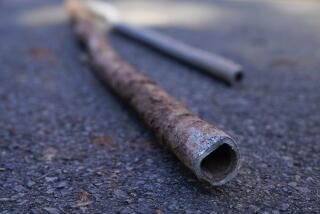Editorial: With healthcare reform stalled, Trump and Pruitt want to repeal and replace clean water standards

Another bid by President Trump to “repeal and replace” a major Obama administration achievement recently got a boost when the Environmental Protection Agency, now led by anti-environmentalist Scott Pruitt, moved to repeal a 2015 clean water rule. That’s a shame.
The Waters of the United States rule was meant to protect the drinking water supply for more than 100 million Americans by clarifying which waterways are covered by the landmark Clean Water Act of 1972, which limits the chemicals and other pollutants that can be discharged into “navigable” U.S. waters. The interpretation of previous rules was muddied by a pair of U.S. Supreme Court decisions, and the 2015 rule brought a good measure of clarity.
When Trump in February signaled his intention to scrap the rule, which is widely known as WOTUS, he complained that it covers puddles and ditches and gets in the way of farmers trying to feed a hungry nation and builders trying to keep the economy on track.
That’s pure Trump — remolding the facts to suit his purposes. The clean water rule might indeed apply to a small pond, but only if it connects with larger waterways and therefore allows any pollutants dumped in it to spread through tributaries to the nation’s drinking water supply. As for ill-defined “puddles,” the rule expressly excludes them. It does apply to irrigation ditches that function as tributaries of downstream waters, but that’s merely a reiteration of preexisting rules. It expressly excludes ditches that fill up only after it rains.
Pruitt appears to be quite at home with the president’s contempt for fact and science. A strong proponent of Trump’s ill-considered decision to withdraw the United States from the Paris climate agreement, Pruitt on Friday announced an initiative to “critique” climate science by recruiting people to debate each side of an issue on which the vast majority of the scientific community long ago reached consensus.
That hostility might explain why both of them dislike the Waters of the United States rule so much. It relies on science to determine whether bodies of water are interconnected and thus protected under federal law, although it acknowledges that science cannot always provide a “bright line” boundary to determine where water begins or ends. Trump and Pruitt apparently would make that determination based on the convenience of polluters.
The WOTUS rule has never been fully implemented. It has been blocked in court because of lawsuits by more than a dozen states, including Oklahoma — where the suit against the Environmental Protection Agency was filed by then-state attorney general and now-EPA administrator Pruitt.
Repealing the rule is one thing — although that won’t necessarily be simple or come without legal challenges. But then what? A new rule-making process can be long and cumbersome, and there will no doubt be lawsuits to keep water sources pure, and lawsuits to allow them to be sullied. The administration will likely continue to reject science (and clean water) in the name of decreasing regulations on polluters. Lawyers, at least, will be happy. As long as they don’t drink the water.
Follow the Opinion section on Twitter @latimesopinion and Facebook
More to Read
A cure for the common opinion
Get thought-provoking perspectives with our weekly newsletter.
You may occasionally receive promotional content from the Los Angeles Times.






